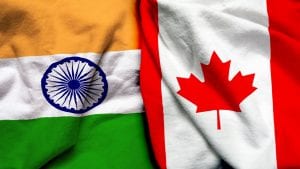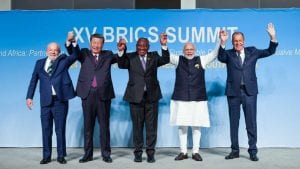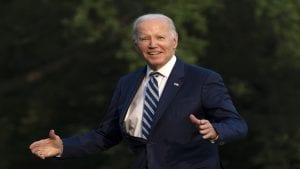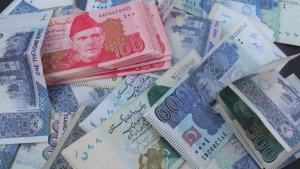India-Canada row — Justin Trudeau fired a gun without the bullet
Summary
For India, it is not a question of Canada but of Counter-Terrorism where it cannot compromise because it impinges directly on its security and sovereignty. But, Justin Trudeau has become increasingly more insecure and dependent on extremist constituents as his popularity has tanked, observes former diplomat Amb. Anil Tigunayat.
PM Justin Trudeau of Canada jumped the gun without the bullet as is the want of many a politicians, who wish to create sensationalism by ranting out baseless accusations of foreign interference without any credible evidence, simply to marshal the public opinion to salvage themselves. It is a given that they don’t gain as much as they lose.
But a sensitive subject like harbouring and enabling extremism and terrorists make it even more questionable since it puts the country’s reputation at stake. Do Canadians support terrorism or extremism, of course not but whether their current leadership does is a question which has been duly proved by the Trudeau legacy.
Case of slain Canadian Sikh separatist militant leader Harmit Singh Nijjar (in June killed by masked gunmen) and Trudeau and his foreign minister eulogising him left no doubt that perhaps he and many others like him thrived due to their patronage.
Moreover, Trudeau accused India — a country that follows ‘zero tolerance’ to terrorism policy and has suffered from violent extremism and terrorism for nearly five decades from across the border. India has also faced externally induced insurgency which is perpetrated with the support of external powers who have made terrorism as the fundamental of their foreign policy with utter impunity from their benefactors and the vocalists in the West.
Trudeau seems to be taking Canada in that direction by actively jeopardising the relationship with India. An irony indeed.
Also Read: India suspends visa service operations in Canada until further notice, says BLS International
His diplomatic indiscretions are far too many. When he came on a bilateral visit in 2018, when India gave a chance to redeem the relationship, he brought along a Khalistani extremist leader even he and family went about shouting their Indian wardrobe. Superficiality and suspicion go hand in hand. This time at G20 he also made remarks that would embolden the Khalistani extremists in his country.
Under the garb of democracy, he allowed Khalistani Referendum in direct affront to India’s sovereignty. If he loves Khalistan so much, why doesn’t he change the name ‘British Columbia’ into ‘Canadian State of Khalistan’. Perhaps, he could win another election.
Also Read: Canadian high commission ‘temporarily adjusting staff presence in India’ amid diplomatic row
Coming to his G20 Summit in New Delhi, PM Modi extended due courtesies to the visiting dignitary, despite India’s deep concerns on separatism and terrorism being directed from Canadian soil against India directly or through Pakistani deep state whose objective was clearly aligned to destabilise India. Apparently, Trudeau raised the extra-judicial killing of Nijjar and potential hand of Indian agencies with PM Modi in Delhi. It was outright rejected as absurd and unsubstantiated with any evidence whatsoever. On the other hand, PM Modi firmly took up various cases, incidents and threats against Indian citizens and diplomats and asked Canada to deal with them appropriately. A statement by Ministry of External Affairs articulated; “We are a democratic polity with a strong commitment to rule of law.”
Such unsubstantiated allegations seek to shift the focus from Khalistani terrorists and extremists, who have been provided shelter in Canada and continue to threaten India’s sovereignty and territorial integrity. The inaction of the Canadian government on this matter has been a long-standing and continuing concern. That Canadian political figures have openly expressed sympathy for such elements remains a matter of deep concern. The space given in Canada to a range of illegal activities including murders, human trafficking and organised crime is ‘not new’, saying it all.
Nearly every single act of murder and violence in Punjab had a link in Canada. Only two days ago a Congress politician was killed in daylight which was commissioned from Canada and claimed on a Facebook post. No doubt the actions and politically motivated riots in 1984 did hurt the sensibilities of many Sikhs but the wounds are being healed. Despite this the Sikhs are proud Indians. Even in Canada it is ONLY a miniscule yet well-oiled politically vociferous groups who overtly prevail on the silent majority of Sikhs and Panjabis who constitute the second largest population outside of Punjab. I guess this is the time for them to speak up .
It is not a question of Canada but of Counter-Terrorism where India cannot compromise because it impinges directly on our security and sovereignty. Hopefully the Five Eyes understand it with their eyes open. Terrorism and Extremism cannot be countered as long as the world powers and countries play around with ‘my terrorist is good and those not with me are rogues’.
Terrorism is Terrorism’..Khalas! In the case of Canada, there is a trail going back to four decades from Trudeau senior to Trudeau Junior. Although they started accepting immigrants including the illegal ones like Nijjar with great alacrity and enabled and provided them to continue their tirade against India. Several militant outfits were raised, which eventually became political actors as well, especially out of British Columbia.
Place of worship — the holy Gurudwaras became their legal habitat and all this with the connivance and political patronage. Kanishka crash when 329 precious lives were lost — no credible action was taken and eventually the criminals were also set free emboldening their enterprise. Gurmeet Singh of the New Democratic Party and known India baiter is also an alliance partner of Justin Trudeau whose own popularity has tanked and hence he has become increasingly more insecure and dependent on such extremist constituents.
During the farmers agitation (2021) he openly issued statement which amounts to interference in India’s internal affairs. Hence it is no wonder that they sing songs in their praise. What an irony!
Result is that these extremist elements have become vociferous and dangerous and are threatening Indian diplomats, citizens and interests apart from creating problems in India.
After the claims made by Trudeau in the House of Commons and his foreign Minister asking an Indian diplomat to leave, the situation has worsened. All these faux pas, without any shred of evidence which has even been averred by the Opposition Leader in the Canadian Parliament.
His Five Eyes partners also do not appear convinced even as they have expressed some concerns and want the perpetrators to be brought to justice. Instead of confronting and taking action against terrorists in their country they are raising the bogey of sovereignty which smacks of utter hypocrisy. They were behind President Bush who talking of 9/11 terrorists, claimed that “we shall smoke them out’ wherever they are and invasion of Afghanistan began when no Afghan was involved in the 9/11 attacks. But the world stood with them since terrorism and extremists are universal threats and global solidarity is a must, but probably not for the Trudeaus.
Meanwhile, bilateral relations continue to go down with threat perceptions increasing for Indians in Canada. Discussion on India-Canada Free Trade agreement have been paused or suspended. Both sides have expelled a diplomat each and more may follow and we might be looking at downgrading the diplomatic representation as well. Indian government has issued an advisory to Indians stating; “In view of growing anti-India activities and politically-condoned hate crimes and criminal violence in Canada, all Indian nationals there and those contemplating travel are urged to exercise utmost caution. Recently, threats have particularly targeted Indian diplomats and sections of the Indian community who oppose the anti-India agenda.”
India has suspended visa services to Canadian citizens to ensure its security.
All this for the snub and snobbery of the Canadian Prime Minister who seems to be hell bent on placing his country in the company of some of our neighbours for whom cross border terrorism and its sponsorship is an article of faith.
Hope the good Canadian citizens will see it as a wake-up call.

Elon Musk forms several ‘X Holdings’ companies to fund potential Twitter buyout
3 Mins Read
Thursday’s filing dispelled some doubts, though Musk still has work to do. He and his advisers will spend the coming days vetting potential investors for the equity portion of his offer, according to people familiar with the matter









 Listen to the Article
Listen to the Article  Daily Newsletter
Daily Newsletter













